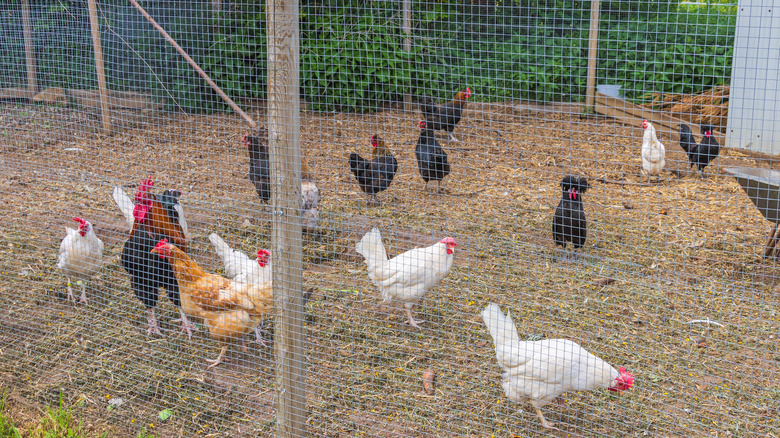The Viral Painting Hack You Need To Know If You Raise Chickens In Your Yard
When it comes to managing your flock, visibility is crucial. However, traditional chicken wire usually poses a challenge. If you've ever tried to look into your chicken coop or run during the height of daylight, you know just how hard it is to see inside. The glare and reflections make it almost impossible to see finer details unless you're standing right up against it.
Whether you're trying to keep an eye on your birds to keep them from bullying one another or trying to monitor those who are sick or injured, the lack of visibility makes it that much more difficult. But there's an easy way to fix this: painting your chicken wire black. Black surfaces create a stronger contrast with the surrounding environment. Even in broad daylight, the black-colored wire stands out more against the background. This contrast makes it easier for your eyes to focus on the prize inside: your chickens. This hack is not magic (well, it kind of is), and physics is to blame for why it works.
Why paint chicken coop wire black
While you might not believe it at first, painting chicken wire black absorbs the light rather than reflecting it. Regular chicken wire reflects light, making it hard to see through during the day. When it's painted black, this no longer becomes an issue.
Painting galvanized metal — as most chicken wire is — with the wrong type of paint may not stay very long and start to peel. Chickens are curious by nature and may ingest the paint, which could make them sick. It's recommended to use a special type of outdoor paint. Rust-Oleum's Protective Enamel black paint is available at Home Depot for about $17 and is a great option for this. Its durable, rust-resistant coating offers long-lasting protection on outdoor metal surfaces. You'll also need a foam roller. The High-Density Foam Mini Roller Kit from Harbor Freight is only $4 and gives you everything you need, including a paint tray.
This painting hack is easy. Take your paint and foam roller and start rolling the paint onto the wire of your chicken coop build. Make sure to cover areas thoroughly to maximize the absorption of the black paint. Allow the paint to dry completely, and you're done. Next time you're finding yourself struggling to see your chickens in their run, keep this trick in mind.
